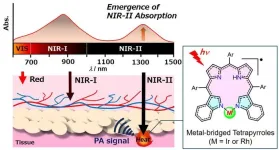How Camellias evolved with the formation of the Japanese archipelago?
Tracing the demographic history of Camellia japonica and Camellia rusticana
2025-01-27
(Press-News.org)
Niigata, Japan – The distribution of plants has been shaped by geological and climatic changes over time through repeated migration, extinction, and adaptation to new environments. The genus Camellia, comprising over 100 species mainly in East Asia, is a representative warm-temperate tree of the Sino-Japanese Floristic Region.
In Japan, four species of Camellia are found, with Camellia japonica and Camellia rusticana being the most well known. C. japonica has a broad distribution from Aomori Prefecture in the cool-temperate zone to subtropical Taiwan and the coastal regions of China, suggesting its high adaptability to different climates. In contrast, C. rusticana is a Japan Sea element plant adapted to heavy snowfall areas. Plants categorized as Japan Sea elements are generally thought to have evolved from closely related species on the Pacific side, and C. japonica and C. rusticana were also believed to follow this pattern. Following this idea, C. rusticana was hypothesized to have diverged from C. japonica as an adaptation to snow-covered environments. However, this hypothesis had not been fully tested scientifically. This study aimed to clarify the evolutionary history of these two species by analyzing their distributional changes using genetic analyses and ecological niche modeling.
Phylogenetic analyses revealed clear differentiation among C. japonica, C. rusticana, and C. chekiangoleosa, a closely related continental species. Their common ancestor is estimated to have diverged approximately 10 million years ago during the Late Miocene, coinciding with the separation of the Japanese archipelago from the continent. This suggests that the two species diverged simultaneously due to geographic isolation, contradicting the previous hypothesis that C. rusticana evolved from C. japonica in response to Quaternary glacial cycles.
The populations of C. japonica are divided into three major groups: northern Japan, southern Japan (including mainland China and Korea), and the Ryukyu-Taiwan region. Among them, the northern population is particularly distinct from the others. Tracing their evolutionary history, analyses revealed that the southern population diverged from the northern population about 3.3 million years ago, followed by the Ryukyu-Taiwan population splitting from the southern population 1.8 million years ago, and finally, the continental population (including Korea) diverging from the southern population 27,000 years ago. These findings indicate that C. japonica, which originally migrated from the continent to the Japanese archipelago, later evolved and eventually recolonized the continent (reverse colonization). This provides key evidence that islands are not evolutionary dead ends but can serve as sources of genetic diversity for continental populations.
This study not only sheds light on the evolutionary history of Camellia but also highlights how the formation of the Japanese archipelago has influenced plant evolution. "By unraveling the history of camellias, we may gain new insights into the evolutionary processes of other plants unique to Japan," says Dr. Harue Abe. Furthermore, the research is not just about understanding the past—it also provides clues for predicting future changes in plant distribution. "As global warming continues, understanding how Camellia species will shift their ranges becomes increasingly important. Our findings will serve as a key reference for predicting these changes," she emphasizes.
END
[Attachments] See images for this press release:

ELSE PRESS RELEASES FROM THIS DATE:
2025-01-27
Niigata, Japan – A group led by the Department of Neurosurgery, Brain Research Institute, Niigata University succeeded in the diagnosis of leptomeningeal disease in diffuse midline gliomas by detecting H3K27M-mutant droplets from circulating tumor DNA of cerebrospinal fluid taken from these patients. In two patients, leptomeningeal disease was diagnosed earlier than with traditional methods such as MRI and cerebrospinal fluid cytology. In one patient, long term survival after the diagnosis of leptomeningeal disease by early ...
2025-01-27
Understanding the science behind meaty tastes and textures could be the key for more people switch to a planet-friendly plant diet, researchers suggest.
Ole G. Mouritsen, a professor of gastrophysics, addresses the urgent need to make changes to culinary cultures where animal-based proteins play a central role.
Replicating a little-known meaty flavour and a sensation of richness could encourage more plant-based eating, he explains.
“To ensure that there is enough food for a growing world population, to lessen the burden on the environment, and to promote healthier, sustainable eating patterns, it ...
2025-01-26
LOS ANGELES —January 26, 2024 — Young patients who have undergone the Ross procedure for aortic valve disease have shown excellent long-term survival, the majority without the need for additional surgery two decades later.
These findings, presented today at the 61st annual meeting of The Society of Thoracic Surgeons (STS), were the result of a 22-year study at the Narayana Institute of Cardiac Sciences in Bengaluru, India.
“The Ross operation can be performed safely with results comparable to mechanical valve replacement,” said the study’s lead author, cardiac surgeon ...
2025-01-26
LOS ANGELES—January 26, 2025—As contemporary surgical practice continues to evolve, patients who undergo surgical lung volume reduction (LVRS) for advanced emphysema may survive longer and with fewer complications than they did in the past—and they may even fare better than those who opt for endobronchial valve (EBV) placement.
At the 2025 Society of Thoracic Surgeons (STS) Annual Meeting, researchers presented risk-adjusted findings that shed new light on treatments for severe emphysema. Despite having shorter hospital stays, lower hospital ...
2025-01-25
LOS ANGELES—January 25, 2025—A late-breaking study presented today at the 2025 Society of Thoracic Surgeons (STS) Annual Meeting reveals that mechanical aortic valve replacements (AVRs) provide significant long-term survival benefits for patients aged 60 and younger compared to bioprosthetic valves. The study, leveraging data from the STS Adult Cardiac Surgery Database (ACSD), offers the most comprehensive analysis to date of prosthetic valve outcomes, encompassing over 100,000 patients.
The study addressed a critical question ...
2025-01-25
LOS ANGELES—January 25, 2025 New research presented at the 2025 Society of Thoracic Surgeons (STS) Annual Meeting reveals that anatomic lung resections, such as lobectomy and segmentectomy, are associated with improved long-term survival compared to wedge resection for patients with early-stage non-small cell lung cancer (NSCLC).
The study analyzed outcomes for more than 32,000 stage 1A NSCLC patients using data from the STS General Thoracic Surgery Database (STS GTSD) with long-term follow-up linked to the National Death Index and Centers ...
2025-01-25
SAN FRANCISCO – Patients with metastatic colorectal cancer (mCRC) harboring BRAF V600E mutations benefitted from first-line treatment with the targeted therapies encorafenib and cetuximab plus a mFOLFOX6 chemotherapy regimen, according to results from the Phase III BREAKWATER trial led by researchers at The University of Texas MD Anderson Cancer Center.
The findings, presented today at the American Society of Clinical Oncology Gastrointestinal Cancers (ASCO GI) Annual Symposium and published in Nature Medicine, demonstrated a 60.9% overall response rate (ORR) with the three-drug combination ...
2025-01-25
Boston – A data analysis from a randomized clinical trial for stage 3 colon cancer patients by investigators at Dana-Farber Brigham Cancer Center found that patients with evidence of residual cancer in their blood after surgery to remove the cancer, may benefit from adding of celecoxib, to post surgery treatment. The analysis showed that patients with positive blood tests for circulating tumor DNA (ctDNA) had worse outcomes in general, but those who were treated with celecoxib, a non-steroidal anti-inflammatory drug, experienced significantly improved disease-free survival.
“This is one of the first studies to show that ctDNA status has predictive utility in terms of selecting ...
2025-01-25
The Alliance for Clinical Trials in Oncology today announced the results of a data analysis from a randomized phase III clinical trial involving patients with stage III colon cancer, which found that adding the drug celecoxib to treatment after surgery might help those who still have traces of cancer in their blood. The analysis showed that patients with signs of cancer in their blood measured by Signatera™, a circulating tumor DNA (ctDNA) test, tended to have worse outcomes. However, those who took celecoxib after surgery had a much better chance of staying cancer-free. These results are being presented in a late-breaking ...
2025-01-25
Tokyo, Japan – Researchers from Tokyo Metropolitan University have developed a new dye that can strongly absorb second near-IR radiation and transform it to heat. Starting with a dye from the bile pigment family, they designed a unique ring structure which can bind rhodium and iridium. Measurements and modeling revealed strong second near-IR absorptions and exceptional photostability. Second near-IR waves easily penetrate human tissue; the new dye may be applied in deep tissue therapies and imaging.
The second near-IR region of the electromagnetic spectrum (1000-1700 nanometers) ...
LAST 30 PRESS RELEASES:
[Press-News.org] How Camellias evolved with the formation of the Japanese archipelago?
Tracing the demographic history of Camellia japonica and Camellia rusticana





